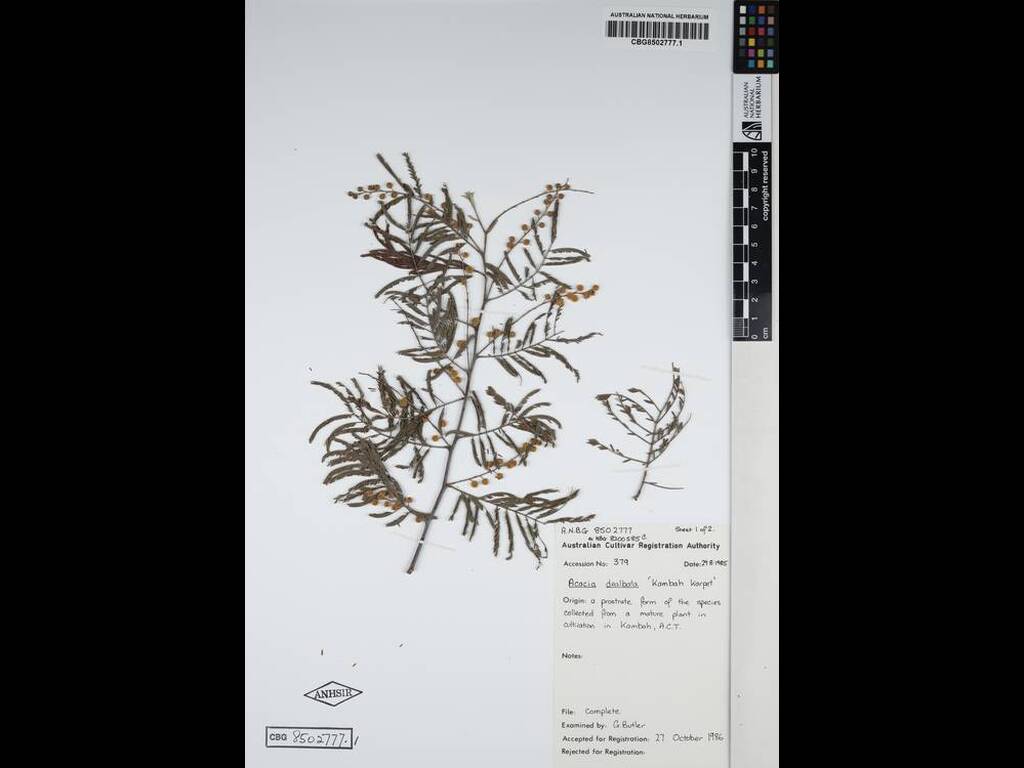Acacia dealbata 'Kambah Karpet'
- File Number
- 379
- ACRA Field Book Number
- 184
- Registration Date
- 26/10/1986
- Application Received
- 01/08/1985
- Family
- Fabaceae
- Cultivar Name
- Acacia dealbata 'Kambah Karpet'
- Origin
- Acacia 'Kambah Karpet' was selected from a mature plant growing in a garden bed near the Health Centre in the Canberra suburb of Kambah. It was the only prostrate plant amongst a number of plants of this species in the planting. The selection was made by Mr.R.B. Hadlow of the staff of the Australian Botanic Gardens in 1982. The cultivar was first received by the Authority in August 1985. Registration applied for by R.B. Hadlow on behalf of the Australian Botanic Gardens, P.O.Box 1777, Canberra 2601.
- Characteristics
- This cultivar is a dense, prostrate form of the species, growing to 3m across. The plant forms a small mound about 200mm high where the main stem arises from the soil. Other than the decumbent to prostrate habit, the features are as for A. dealbata. All suckers that arise from this plant retain the prostrate habit. Diagnosis: Acacia 'Kambah Karpet' is distinguished by its decumbent to prostrate habit. Other notes: This plant has been grown in the Australian National Botanic Gardens and has proven to be a hardy, dense groundcover, well suited to a variety of soil and moisture conditions. It is very drought resistant and frost hardy in Canberra. Propagation of Acacia vegetatively has often proved difficult in the past, and as vegetative propagation is required to preserve the cultivar form, the following advice on propagation is presented. Acacia'Kambah Karpet' has been most successfully propagated from firm (semi-hardened) material taken in autumn. Tip material 75 to 100mm long can be used as well as taking a further cutting down the stem. No success has been recorded at the Australian National Botanic Gardens for spring or early summer cuttings of soft tip material. Indolebutyric Acid (I.B.A.) at 2000ppm in 50% alcohol used as a five second dip has been the most successful hormone used in propagation. Suckers taken from the cultivar also retain the same form.
- Cultivation
- As for Acacia dealbata
- Publication
- Wrigley, J.W. & Fagg, M. (1988), Australian Native Plants: propagation, cultivation and use in landscaping Edn. 3: 575
- Colour Coding
- RHS Colour Code 1966.older leaves:greyed-green group 189A.new leaves: yellow-green group 146B.
- Propagation
- Cuttings
- Applicant Name
- R.B. Hadlow
- Uses
- Groundcover suitable for mass planting or mixed in a shrubbery, or as a spectacular feature plant, Also very useful for large display pots.
- Availability
- Specialist native plant nurseries
- ANBG Accession Numbers
- ACC379; ACRA184; CBG8502777.
- NSL ID
- -
